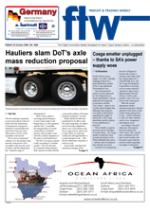Road transport remains one
of the largest consumers
of energy and creators of
pollution and while energy
efficiency in the transport
sector has improved
dramatically, it remains a
concern.
Allen Jorgensen, media
research officer for the
Railroad Association of South
Africa, says rail offers a
much-needed alternative.
“The cost, supply and
consumption of energy
has become a major
environmental concern in
recent times. From 1978 to
1988 the energy needed to
move one passenger one
kilometre was reduced by 3%
but the number of passengers
increased by 31%. In the
freight sector the increase was
even greater,” says Jorgensen.
“It is clear that a careful
examination of the overland
transport modal mix is
urgently required and that no
doubt, rail has an important
role to play.”
According to Jorgensen,
electric haulage by rail
reduces the carbon footprint
quite substantially.
“A road vehicle on the N3
uses 280-300 litres of diesel
for a single run from Durban
to Gauteng. At 30 million tons
of through road traffic per
annum, or one million trips,
280 million litres of fuel is
consumed. Such traffic on
rail would rely almost entirely
on electricity generated from
coal – a much more abundant
resource.”
Jorgensen says rail also
uses less space as a singletrack
railway line can handle
four to eight times the volume
of a two lane bi-directional
road.
“Yes, road transport is fast
and flexible, but the impact
on the environment is greater.
Nearly all road transport
operations rely on diesel or
petrol usage while rail in
comparison relies largely
on electricity generated in
thermal power stations.”
Jorgensen believes that
to make any informed
infrastructure investment,
total transport costs must be
factored in which include
energy use and externalities
including environmental
degradation, accidents,
congestion and related costs.
“Only once all these costs
are factored into the total cost
of transportation can we make
an informed decision on what
infrastructure to invest in.”
Rail champion spells out carbon ‘cost’ of road usage
23 Oct 2009 - by Liesl Venter
0 Comments
FTW - 23 Oct 09

23 Oct 2009
23 Oct 2009
